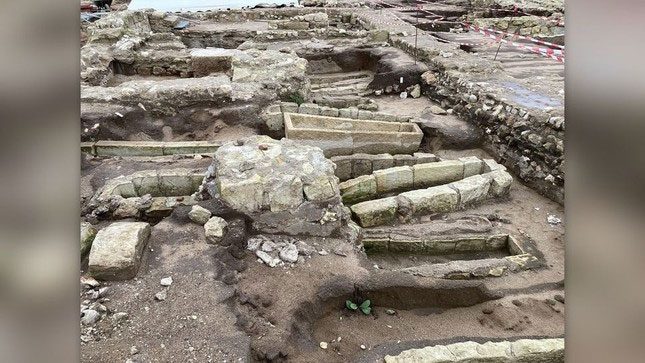The excavation of a medieval monastery in France has uncovered over 1,000 graves, including victims of the plague, as well as the remnants of a village nearly 1,200 years old.
The dig at Beaumont Monastery reveals that this monastery was in use for nearly eight centuries before being closed due to the events of the French Revolution. This marks the first time a monastery in Europe has been fully excavated, providing new insights into the development of Catholic monasteries.
Located outside Tours in the Loire Valley of France, about 178 kilometers southwest of Paris, Beaumont Monastery was founded in 1002 on a site that had been occupied by the village of Belmons since at least 845. Historical records indicate that the monastery quickly developed, becoming the largest community of nuns in the region.

Recently unearthed coffins. (Photo: © Jean Demerliac, Inrap).
However, in 1789, amid the French Revolution which ultimately led to the executions of Louis XVI and Marie Antoinette, the state confiscated the monastery, and the remaining 46 nuns were expelled from Beaumont. The church and associated buildings were eventually demolished in the early 19th century.
A Unique Complex
The archaeological excavation at Beaumont Monastery began in September 2022, led by Philippe Blanchard from the National Institute for Preventive Archaeological Research (Inrap), and was completed in December 2023.
Blanchard stated in a press release: “This is a unique complex. We have excavated many elements of this monastery, including the entire church, the entire monastery, all the auxiliary buildings, and all the facilities such as the nuns’ residence, dining hall, kitchen, washrooms, guest rooms, wine cellar, dovecote, ovens, water tanks, plumbing, toilets, and more than 1,000 graves from various time periods.”
The research team also found physical evidence of the village of Belmons.
This work has so far indicated that the church’s monastery underwent at least two significant structural changes before its demolition. One or two centuries later, the church expanded with the addition of aisles along the nave, or the central part of the church where the congregation was organized.
However, smaller renovations also occurred throughout the eight centuries the monastery was in use. Blanchard noted: “They added rooms, rebuilt bricks, and added toilets. They were continually making changes.”
He further added: “We know that a plague outbreak occurred in 1563, and in the same week, nine nuns—two on the same day—died and were buried in the same grave.”
Blanchard mentioned that there could also be senior church members among the graves, as texts refer to the grave of an abbess buried with dozens of urns.
The abbess in question may be Madame de Bourbon-Condé, a granddaughter of Louis XIV. She became a nun around 1720 and was abbess of Beaumont in 1732, passing away in 1772.
The abbess likely lived a regal life, with her own residence and servants managing it. A tea brewing tool made of porcelain from the 18th century discovered during the excavation indicates that the nuns imported fine ceramics from China at significant expense.


















































